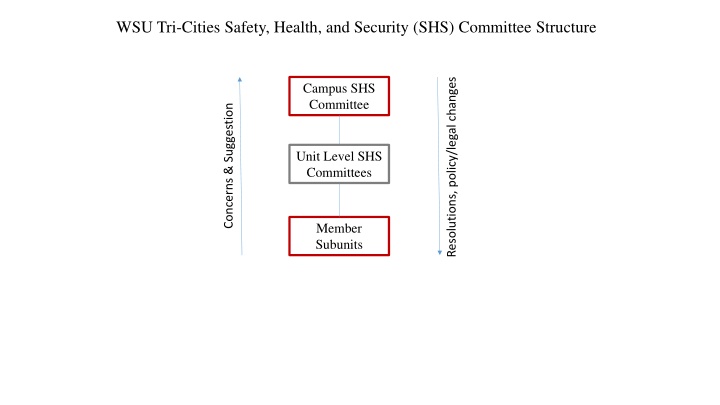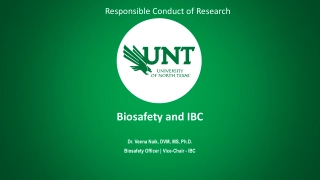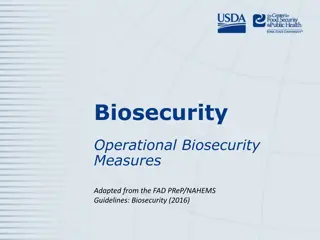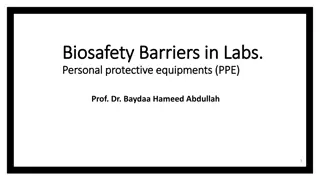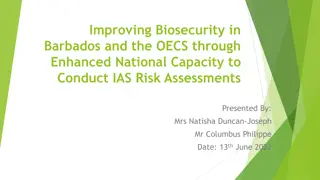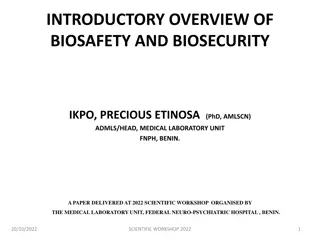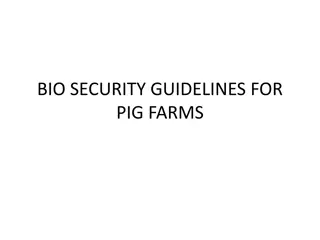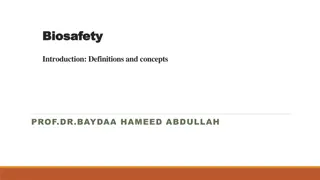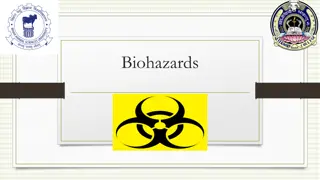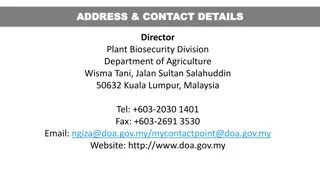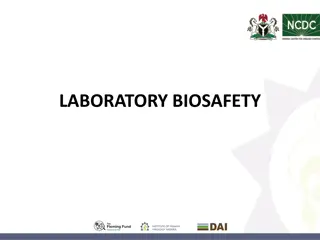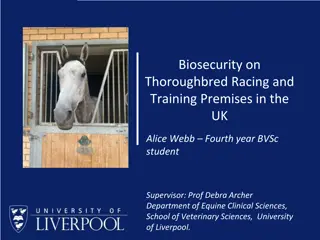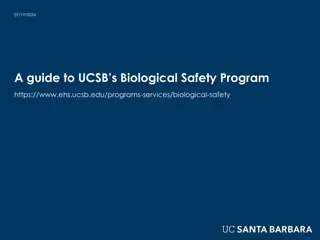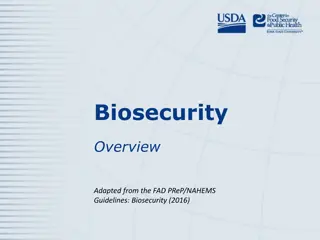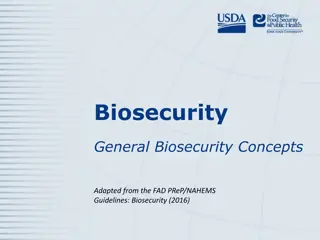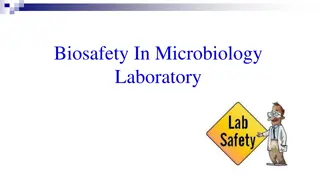Biosafety and Biosecurity Practices: Enhancing Laboratory Safety
Framework for containment of biohazards including safe practices, safety equipment, and facilities to protect workers, communities, and the environment. Learn about biosafety practices, policies, and procedures during National Biosafety Month.
Download Presentation

Please find below an Image/Link to download the presentation.
The content on the website is provided AS IS for your information and personal use only. It may not be sold, licensed, or shared on other websites without obtaining consent from the author.If you encounter any issues during the download, it is possible that the publisher has removed the file from their server.
You are allowed to download the files provided on this website for personal or commercial use, subject to the condition that they are used lawfully. All files are the property of their respective owners.
The content on the website is provided AS IS for your information and personal use only. It may not be sold, licensed, or shared on other websites without obtaining consent from the author.
E N D
Presentation Transcript
WSU Tri-Cities Safety, Health, and Security (SHS) Committee Structure Resolutions, policy/legal changes Campus SHS Committee Concerns & Suggestion Unit Level SHS Committees Member Subunits
Member Subunits Member subunits are the functional groups within the university. Each of these groups is placed within a Unit Level Safety, Health, and Security Committee (ULC) based on similarity of on-the-job hazards faced by its employees. ULCs and their member subunits are detailed on the next slides. Member subunits may form an additional subcommittee(s) within the subunit, at their discretion. Activities of these subcommittees must be coordinated with the ULC Chair, in order to prevent duplication of efforts between subunits. However, each member subunit must elect one employee as its ULC representative. For example, within the Business office, employees in Payroll services and Contracts may form separate subcommittees, but both will be represented by the Business office ULC representative. Academic ULC: Administrative Operations Research Student Services Students Labs Non-lab Caf Biofuels Cooper Lab EH&S Advising Arts Business Education Library Running Start Advancement Business Office HR MarCom Professional Dev. Copy Center Custodial Grounds IT Maintenance Security Engineering Fine Arts Nursing Sciences Admissions Early Outreach Student Affairs Member Subunits: Student Body Representative Environmental Sciences FEQL V&E
Unit Level SHS Committees The Unit Level Safety, Health, and Security Committees (ULCs) will: Provide a forum for organizations within WSU-TC to identify and discuss safety- and security-related concerns with other units with similar functions and processes. Discussion of such concerns may allow for them to be resolved through common experiences, shared processes, and mutual support. In the event that additional assistance is required, the chair of the ULC shall present the issue to the Campus SHS Committee for further discussion. Serve as conduits between their member subunits and the Campus SHS Committee Monitor their member subunits compliance with safety and security programs, policies, and regulations, as well as implementation of new requirements communicated by the Campus SHS Committee as a result of regulatory/policy changes and/or corrective actions resulting from incidents, inspections, or identified conditions Assist with promotion of safety awareness, including dissemination of information to their member subunits Membership of ULCs: One representative must be elected from the subunit employees, and shall not be part of the unit s management. Each ULC must elect a committee chair and a vice chair from its members, and is limited to no more than 8 members. The research ULC will be chaired by the EH&S Lab Safety Coordinator.
Campus SHS Committee The Campus Safety, Health, and Security (CSHS) Committee will: Advising EH&S: Make recommendations for systematic improvements. Problem-solving: In the event that a ULC is not able to resolve an issue, or that issue has relevance outside of an individual ULC, the CSHSC will collaborate to find resolution. The CSHSC will call upon campus and University resources when needed. Solutions requiring policy changes and/or capital investment must be reviewed by the Chancellor s Office prior to implementation. Communication: The CSHSC will share information from the Chancellor s Office or WSU System. Each member will be responsible for the communication and implementation of Safety information from the committee network, policies, and procedures. In turn, the CSHSC will provide technical and regulatory input to the Chancellor s Office through the chair about issue trends, feedback for improvements, policy development, and requested information. Measurement/Accountability: Each CSHSC member will monitor and report ULC performance with safety incidents, programs, policies, and practices to the ULC. The CSHSC will review reports and inspections to identify trends and hazardous conditions. Membership of CSHS: Chair: EH&S/Security Supervisor Members: Facilities Director, chairs of the Unit-Level SHS Committees
Procedures for all Committees Meetings will last no more than 1 hour, unless extended based on agreement of the committee Meetings will occur no less than every 2 months (it is recommended that ULC meetings and CSHSC meetings alternate) The committee chair shall lead the conduct of the meeting. Roberts Rules are not necessary, but may be followed at the chair s discretion. Minutes must be kept for all meetings of the CSHSC, ULCs, and for any subcommittees formed by member subunits. The vice chair will be responsible for keeping minutes. Those minutes must be made available to employees represented by the committee as soon as possible, and must be transmitted to the chair of the relevant ULC prior to the ULC s next meeting. Minutes of all ULC meetings must be provided to the CSHSC Chair. Agendas will be distributed no less than 2 days before each meeting. For all meetings (ULC and CSHSC), agendas will include: Roll call (can be silent) Safety topic 5 minute discussion of a new, timely, or seasonal topic with wide relevance. Does not have to be limited to campus issue. Any committee member can volunteer a topic, if none is raised the chair must provide one. Report from the chair to include new information such as new regulations, new communications from another committee or campus, and incident reports received since the last CSHS meeting Report from each representative Each representative will provide a summary of their most recent ULC meeting, including any issues raised and proposed solutions, followed by information on implementation of solutions proposed by previous meetings. Old business items must be specified individually any unresolved topics raised from previous meeting New business items must be placed on agenda via contact with the committee chair prior to the meeting. All topics must be concise in order to stay within the meeting time limit. It is the responsibility of the committee chair to ensure that the meeting stays focused and on task, and to ensure that conversations do not deviate from true safety/security concerns. Where appropriate, members of the CSHS and/or ULCs may be appointed to attend external committee meetings including representatives from other campuses (such as the Emergency Management committee, Risk Management Committee, Cyber Security Committee, etc.). When relevant topics are discussed in these external meetings, attendees will be invited to report to the CSHS and the information obtained will be disseminated to the ULCs and their member subunits as appropriate.
